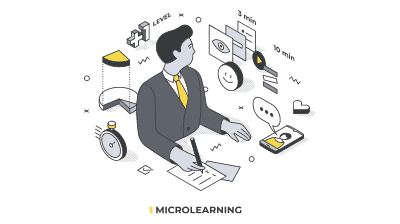
Small. Short. Focused. These three words aptly describe the core of microlearning. However, leveraging the power of best practices for microlearning content creation can make it work.
Did you know back in the 1880’s psychologist Hermann Ebbinghaus came up with a concept called the forgetting curve, a study that estimates 50% of all information gained by a person is forgotten within a day and up to 90% of the same information is washed away within a month. This is not a positive sign for learning a new skill or the overall learning journey.
On the contrary, microlearning plays a significant role in combatting the forgetting curve by aiding factors such as spaced repetition of information, bite-sized format, just-in-time learning, and more.
What is the definition of microlearning?
Microlearning, known as bite-sized learning, is an instructional approach designed to deliver learning content in small, focused, and easily digestible units. It is a fundamental that breaks down complex topics or skills into bite-sized modules that can be attempted and completed quickly. It is a learning session typically ranging between 15-20 minutes. Microlearning often deploys multimedia elements, such as infographics, videos, quizzes, or interactive modules, to improve engagement and facilitate learning.
How can microlearning help?

Today the way we work has changed dramatically. Even though work has become flexible, attention span is growing shorter, as people wear different hats at work. Therefore, it is becoming near impossible for people to set aside even an hour or two to focus on professional growth even though they want to.
Additionally, microlearning can be highly beneficial for learners in various ways. Elements such as time efficiency, flexibility, and accessibility, continuous learning, improved retention, targeted learning are elements that work towards enhancing learner engagement, retention, and application of learning.
“Research reveals that 80% of employees choose microlearning over traditional methods, urging us to seize the opportunity and harness the potential of this transformative eLearning strategy."
7 Best Practices for Creating Effective Microlearning Content
1. Keep it Bite-sized:
Microlearning is a concept designed to have great convenience of time and access in the fast-paced world. It particularly appeals to learners looking for precise, just-in-time information to stay updated and enhance performance.
Therefore, keeping the content concise and focused is the key. Break down complex topics into small, digestible chunks that can be consumed in a short timeframe. Short lessons enable learners to make the most of the information available easily and increase their engagement.
2. Ensure Mobile Compatibility
In the era of smartphone proliferation, it is highly recommended to design microlearning content to be mobile-friendly, as learners most often access their phones or tablets for easy access to information. Additionally, to deliver seamless and engaging microlearning content, ensure the content is responsive and displays appropriately across different devices and screen sizes. This enhances the accessibility quotient and allows learners to engage with the content anytime, anywhere.
3. Use Visuals & Videos to Enhance Learning
Visuals and videos are an incredible way of taking eLearning to the next level. Given that the average attention span of an individual is decreasing rapidly, videos and visuals can be a great way to grab the learner’s attention and improve student engagement, employee training, and customer service.
As best practices for creating microlearning content, incorporating multimedia elements such as images, videos, infographics, or audio can make the content visually appealing and engaging. Multimedia elements can enhance understanding, capture learners’ attention, and share information more effectively than text alone.
4. Leverage AI for Personalization & Adaptive Learning
AI can significantly enhance personalized and adaptive learning in the context of microlearning. There are various ways in which the potential of AI for eLearning can be harnessed to bring out the best in eLearning experience.
Factors such as learner profiling, content recommendations, adaptive learning pathways, intelligent feedback and remediation, and natural language processing can provide learners with tailored content for better outcomes.
5. Incorporate Gamification Elements to Promote Engagement
Over the years, the eLearning industry has continuously adapted to change and making optimal use of technology to improve the overall learning landscape. In recent times, blending gamification with microlearning has been one of the most effective combinations to make learning more effective.
L&D professionals have used this strategy to make learning more learner-centric.
Here are a few winning ways to incorporate gamification in your corporate microlearning setup:
- Incorporate points, badges, and leaderboards
- Add challenges and quizzes
- Emphasize storytelling and narrative
- Make room for feedback and progress tracking
6. Align with Real-life Application:
Microlearning is more than a buzzword. It is a technique widely used by corporates across the globe. However, ensure that microlearning content is relevant and applicable to learners’ real-life situations to make the most of this highly engaging and promising learning technique. Share examples, case studies, and scenarios demonstrating how the information, knowledge, or skill can be used in practical contexts.
7. Use Micro-assessments:
Micro assessments are a great way to assess learners with busy work commitments. Such assessments work as an excellent strategy for making assessments stress-free. However, the best way to get the most out of this is to include short assessments or knowledge checks with the microlearning module to reinforce learning and assess comprehension. These assessments can include quizzes, multiple-choice questions, or short interactive exercises. This approach helps learners reinforce their understanding and identify areas that require further review.
Learn more about how to use microlearning in corporate training.
The Final Take
In the digital era, bite-sized content has now started to gain rapid popularity, given the range of benefits it brings along. Since bite-sized information gives learners the ease and convenience of learning, just sparing a few minutes from their busy schedules makes all the difference.
Today, more and more businesses are adopting a microlearning approach to their corporate training structure to provide employees with the information they need quickly.
Therefore, implementing the best practices of creating microlearning content helps businesses enhance learner experiences.
If you too want to implement the power of microlearning in your business, write to us at: contact@harbingergroup.com






